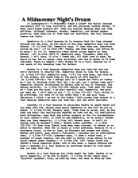A ‘Midsummer Nights Dream’ is, above all else, a play about metamorphosis, the alteration or change from one state into a wholly different entity. The changes from childhood to adulthood, and from singleness to marriage are central, but the theme also extends to other ways an individual can reach beyond their limited identity, in particular taking part in or watching a play. From this perspective the hero of the drama may well be Bottom who, for all his deficiencies, has the natural wisdom to accept any role in which he finds himself and the positive spirit to see it through in style. A direct example of a physical and character metamorphosis, Bottom goes from simple weaver, through magically transformed lover of the fairy Queen to stage hero Pyramus – Shakespeare reiterating the power and versatility of metamorphosis through this.
Love is a consistent motif throughout the text, evident in the metamorphosis of the aforemented as Robin and Oberon fall rapidly in and out of love with the two women (albeit through the application of the fairies magic), adoring and deriding their partners by turns, while confidently proclaiming all the while that their behaviour is prompted by judgement and reason. Again reiterating comedic undertones of the play in general.
‘A Midsummer Night’s Dream’ is thematically a marriage play, another medium through which metamorphosis is utilised in this play. The quintessential example of metamorphosis, marriage takes two seeming opposites (two differing personas with conflicting aspirations and ideals) and combines them into a cohesive entity that is better than the two were separately (e.g.: that of Theseus and Hippolyta).
Both physical and ideological metamorphosis have a pivotal role in the play, the changes themselves are not predominantly arbitrary supernatural acts (as for example Ovid’s ‘Metmorphoses’ a book that heavily influenced this text). The changes that do not allude to this consensus are the short-term plot devices such as the ass’s head and the magic juice that controls Robin and Oberon. The major transformations – from rehearsal to performance, from child to adult, from single people to couples – each involve a permanent growth from one state to the next.
‘A Midsummer Night’s Dream’ consistently takes apparent oppositions and demonstrates either that they are natural stages in such a process (youth and age, celibacy and sex, etc.) or that they are mutually supportive pairs (day and night, male and female, city and wood, reason and imagination). Each side of these pairs has its own positive and negative aspects. Throughout the play there are several prevalent metamorphoses – the role reversal of the forest; becoming supportive to the characters after initially appearing threatening; Bottom transcending his persona to become a hero and the revelation of Theseus’ true nature (thus contradicting his reputed heroics).
Metamorphosis is also employed directly a as plot device. This is prevalent in the contrast between the sustained complaining of Egeus’ initial appearance and the rapid capitulation of his second in Act IV, though this could be discerned as a narrative discrepancy on Shakespeare’s part, he is merely a functional character, included in the play not for his intrinsic interest but to further the story.
Indeed, the consistent motif of metamorphosis would suggest that this play has been heavily influenced by Ovid and various other Greek literary works such as X and Y – which also detail the power and mysticism of metamorphosis. Metamorphosis, central to Ovid's opus, is clearly represented in Midsummer Night's Dream by Bottom's partial transformation to a fêted donkey (a reference to another Metamorphoses, that of Apuleius). More subtle metamorphosis can be seen in the many love-relationships among fairies and mortals. Also, Titania’s name and much of her speech on the disorder and shifting of the seasons (Act II Scene 1) is reminiscent of Ovid’s work.
In summary, Shakespeare expresses the concepts of metamorphosis through emotive diction and the vivid imagery of the transformations that serves reiterate the power of the alterations themselves and the extent of which the characters are subject to them. Metamorphosis is utilised not only to convey the fundamental themes of the text but also to underline characterisation and further the plot when required. The power of metamorphosis in its ability to alter both ideological and physical form accentuates its mythical eminence.








